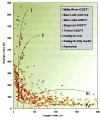About This Item
- Full text of this item is not available.
- Abstract PDFAbstract PDF(no subscription required)
Share This Item
The AAPG/Datapages Combined Publications Database
Alaska Geological Society
Abstract
Bristol Bay-Alaska Peninsula Region, Overview of 2004–2007 Energy Research - Abstract
Our work, and final report this year, (www.dggs.dnr.state.ak.us/publications; and www.dog.dnr.state.ak.us/oil) evaluates the Tertiary and Mesozoic petroleum systems that partly control the hydrocarbon potential of this frontier basin, and summarizes the fundamental reservoir characteristics of potential basin targets. Prospective reservoir lithologies have been quantified using about 300 porosity and permeability samples and indicate viable reservoirs, particularly in the Miocene age Bear Lake Formation. Although 35 wells have been drilled on the Alaska Peninsula; most reported oil and gas shows, none has produced commercially. New field data identify petroleum system requirements: 1) Reservoirs: good Tertiary strata (743-meter - 9,000-feet thick Miocene-age Bear Lake Formation), 2) Seals: intra-reservoir seals (Cook Inlet-like) with 250–2,500 feet hydrocarbon column, 3) Structures and traps: both structural and stratigraphic, 4) Source indicators: thermogenic gas at Port Moller hot springs; Mesozoic source (5.28% total organic carbon in Kamishak Formation at Puale Bay); oil seep southwest of Puale Bay (associated gas is 91% methane, 7 % nitrogen, and 2 % carbon dioxide; Tertiary and Cretaceous coals and carbonaceous shales, and 5) Oil-window maturity: Tertiary stratigraphy (for example, Miocene Bear Lake Formation vitrinite reflectance of Ro = 0.5 - 0.8) and Kamishak Formation pyrolysis. Offshore federal water resource estimates are 753 million barrels of oil and natural gas liquids, and 244 million m3 (8.6 trillion ft3 [TCF]) gas (U.S.MMS, 2006). Probabilistic resource assessment is not part of our current project. The Triassic age, Kamishak Formation has a mean total organic content (TOC) of 1.52% with a high of 5.28%; 18 of 31 samples were greater than 1.0 %. Tmax values average 434°C (813°F) for Kamishak samples, indicating that it is near the boundary of immature and mature source rocks. This is supported by the relatively low productivity index (PI) values averaging 0.09. Hydrogen index (HI) values range from 8 to 785 (mean: 380) and oxygen index (OI) values range from 8 to 806 (mean: 108). Kamishak Formation samples have, on average, oil prone kerogen, and Kialagvik Formation rocks have highly oil-prone source kerogen. Apatite fission-track analyses of NAS COST #1 well samples indicate a present-day heat flow of 6 mW/m2 and 31 °C/km (141 °F/mi) geothermal gradient. This four-year program was funded by the U.S. DOE, AKDGGS, AKDOG, and Bristol Bay Native Corporation.
Acknowledgments and Associated Footnotes
1 Rocky R. Reifenstuhl: Alaska Division of Geological & Geophysical Surveys, 3354 College Road, Fairbanks, Alaska 99709; [email protected]
Copyright © 2014 by the Alaska Geological Society


